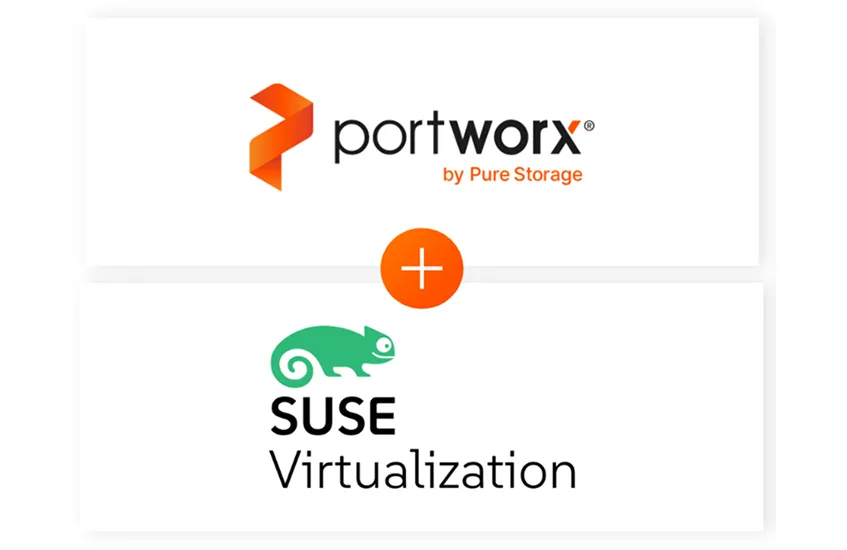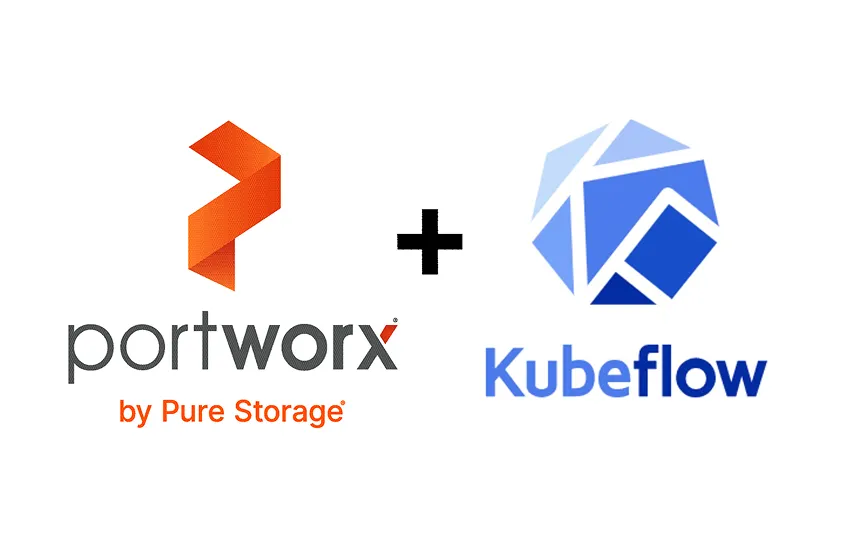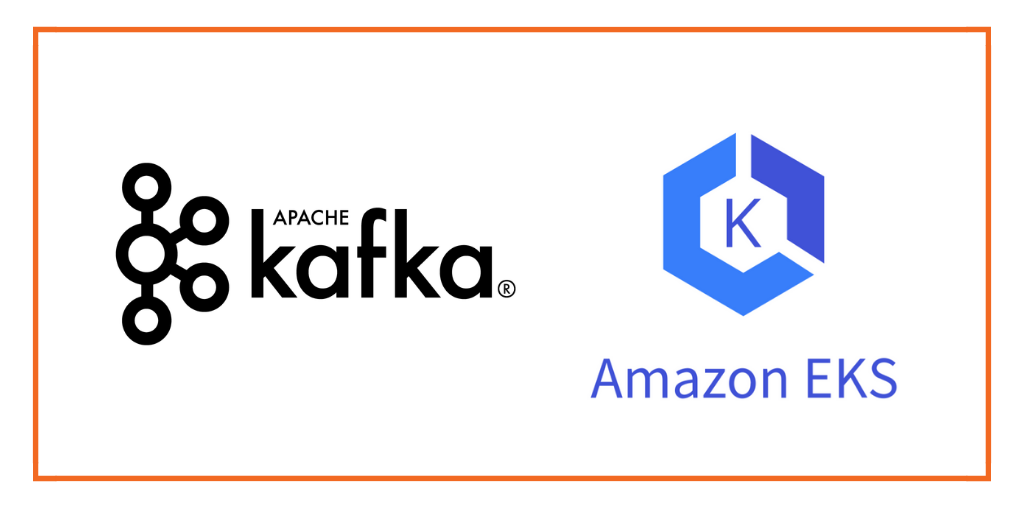
This post is part of our ongoing series on running Kafka on Kubernetes. We’ve published a number of articles about running Kafka on Kubernetes for specific platforms and for specific use cases. If you are looking for a specific Kubernetes platform, check out these related articles.
Running HA Kafka on Azure Kubernetes Service (AKS)
Running HA Kafka on Google Kubernetes Engine (GKE)
Running HA Kafka on Red Hat OpenShift
Running HA Kafka on Amazon Elastic Container Service (ECS)
Running HA Kafka on IBM Kubernetes Service (IKS)
Running HA Kafka with Rancher Kubernetes Engine (RKE)
Running HA Kafka on IBM Cloud Private
And now, onto the post…
Amazon Elastic Container Service for Kubernetes (EKS) is a fully managed Kubernetes environment running in AWS. With Amazon EKS customers get a highly-available, secure Kubernetes control plane without needing to worry about provisioning, upgrades, or patching. Amazon EKS is certified by the Cloud Native Computing Foundation (CNCF) as Kubernetes conformant, which means it supports all existing plugins and tooling from the Kubernetes community, including Portworx.
Portworx, an EKS launch partner, is a cloud native storage platform to run persistent workloads deployed on a variety of orchestration engines including Kubernetes. With Portworx, customers can manage the database of their choice on any infrastructure using any container scheduler. It provides a single data management layer for all stateful services, no matter where they run.
This tutorial is a walk-through of the steps involved in deploying and managing a highly available Kafka cluster on EKS as a Kubernetes StatefulSet. Kafka is a popular open source streaming platform that can be used with scenarios such as streaming clickstream data from web applications and sensor data from IoT devices. Portworx customer NIO, for example, uses Kafka to stream data off of self-driving cars. As a stateful application, Kafka itself needs a solution for persistence but so does one of its primary dependencies, ZooKeeper.
In summary, to run an HA Kafka cluster on EKS you need to:
- Install an Amazon EKS cluster by following instructions in the EKS docs
- Install a cloud native storage solution like Portworx as a daemon set on EKS
- Create a storage class defining your storage requirements like replication factor, snapshot policy, and performance profile
- Deploy ZooKeeper as a StatefulSet on Kubernetes
- Deploy Kafka as a StatefulSet on Kubernetes
- Test failover by killing or cordoning nodes in your cluster
- Perform backup and restore Kafka nodes
How to set up an EKS cluster
Portworx is fully supported on Amazon EKS. Please follow the instructions to configure an Amazon EKS cluster.
You should have a three node Kubernetes cluster deployed based on the default EKS configuration.
$ kubectl get nodes NAME STATUS ROLES AGE VERSION ip-192-168-13-157.us-west-2.compute.internal Ready <none> 7m v1.11.5 ip-192-168-48-2.us-west-2.compute.internal Ready <none> 7m v1.11.5 ip-192-168-66-242.us-west-2.compute.internal Ready <none> 7m v1.11.5

Installing Portworx on Amazon EKS
Installing Portworx on Amazon EKS is not very different from installing it on any other Kubernetes cluster. Portworx EKS documentation has the steps involved in running the Portworx cluster in a Kubernetes environment deployed in AWS.
Once the EKS cluster is up and running, and Portworx is installed and configured, we will deploy a highly available Kafka and ZooKeeper StatefulSet.
The Portworx cluster needs to be up and running on EKS before proceeding to the next step. The kube-system namespace should have the Portworx pods in Running state.
$ kubectl get pods -n=kube-system -l name=portworx NAME READY STATUS RESTARTS AGE portworx-9bq7h 1/1 Running 0 2m portworx-gtnln 1/1 Running 0 2m portworx-kpt9v 1/1 Running 0 2m

Create a storage class for ZooKeeper and Kafka
Once the EKS cluster is up and running, and Portworx is installed and configured, we will deploy a highly available Kafka cluster in Kubernetes.
Through storage class objects, an admin can define different classes of Portworx volumes that are offered in a cluster. These classes will be used during the dynamic provisioning of volumes. The storage class defines the replication factor, I/O profile (e.g., for a database or a CMS), and priority (e.g., SSD or HDD). These parameters impact the availability and throughput of workloads and can be specified for each volume. This is important because a production database will have different requirements than a development Jenkins cluster.
In this step, we will create two storage classes for ZooKeeper and Kafka clusters.
Notice that we the replication factor for ZooKeeper storage class is set to 1. That’s because ZooKeeper servers keep their entire state machine in memory, and write every mutation to a durable WAL (Write Ahead Log) on storage media. When a server crashes, it can recover its previous state by replaying the WAL. To prevent the WAL from growing without bound, ZooKeeper servers will periodically snapshot their in-memory state to storage media. These snapshots can be loaded directly into memory, and all WAL entries that preceded the snapshot may be discarded.
Since ZooKeeper keeps the data in memory with an in-built recovery mechanism, we don’t need to configure Portworx volumes for replication.
We also defined a separate group for ZooKeeper and Kafka. This is helpful if we take 3DSnaps that are consistent across the whole cluster.
$ cat > px-ha-sc.yaml << EOF kind: StorageClass kind: StorageClass apiVersion: storage.k8s.io/v1 metadata: name: portworx-sc provisioner: kubernetes.io/portworx-volume parameters: repl: "1" priority_io: "high" group: "zk_vg" --- kind: StorageClass apiVersion: storage.k8s.io/v1 metadata: name: portworx-sc-rep3 provisioner: kubernetes.io/portworx-volume parameters: repl: "3" priority_io: "high" group: "kafka_vg" EOF
Create the storage classes and verify their availability in the default namespace.
$ kubectl create -f px-ha-sc.yaml storageclass.storage.k8s.io/portworx-sc created storageclass.storage.k8s.io/portworx-sc-rep3 created $ kubectl get sc NAME PROVISIONER AGE portworx-sc kubernetes.io/portworx-volume 23s portworx-sc-rep3 kubernetes.io/portworx-volume 23s standard (default) kubernetes.io/gce-pd 52m stork-snapshot-sc stork-snapshot 44m
Deploying ZooKeeper StatefulSet on Amazon EKS
As of v0.8, Kafka uses ZooKeeper for storing a variety of configurations as a key/value pair in the ZooKeeper data tree and uses them across the cluster in a distributed fashion. Our first task will be to deploy a 3 node ZooKeeper cluster using a StatefulSet backed by a Portworx volume.
We will then deploy a Kafka StatefulSet which uses our ZooKeeper cluster and also has Portworx volumes with 3 replicas. Using these replicas, we can have fast failover of the Kafka nodes and eliminate the I/O load during the rebuild. Additionally, because Portworx provides HA for Kafka, a typical customer can run fewer Kafka brokers for the same level of reliability, significantly reducing compute costs. Running 3 brokers instead of 5 is a 40% cost savings.
We will start by creating three objects.
1- A ConfigMap to inject configuration data into our ZooKeeper containers
2- A PodDisruptionBudget to limit the number of concurrent disruptions that ZooKeeper application experiences when we do maintenance operations on Kubernetes nodes
3- and finally, a Service for ZooKeeper so that Kafka can connect to the ZooKeeper cluster.
$ cat > zk-config.yaml << EOF
apiVersion: v1
kind: ConfigMap
metadata:
name: zk-config
data:
ensemble: "zk-0;zk-1;zk-2"
jvm.heap: "512M"
tick: "2000"
init: "10"
sync: "5"
client.cnxns: "60"
snap.retain: "3"
purge.interval: "1"
---
apiVersion: policy/v1beta1
kind: PodDisruptionBudget
metadata:
name: zk-budget
spec:
selector:
matchLabels:
app: zk
minAvailable: 2
---
apiVersion: v1
kind: Service
metadata:
name: zk-headless
labels:
app: zk-headless
spec:
ports:
- port: 2888
name: server
- port: 3888
name: leader-election
clusterIP: None
selector:
app: zk
EOF
$ kubectl create -f zk-config.yaml configmap/zk-config created poddisruptionbudget.policy/zk-budget created service/zk-headless created
Now, deploy the ZooKeeper StatefulSet.
$ cat > zk-config.yaml << EOF
apiVersion: apps/v1
kind: StatefulSet
metadata:
name: zk
spec:
selector:
matchLabels:
app: zk
serviceName: zk-headless
replicas: 3
template:
metadata:
labels:
app: zk
annotations:
pod.alpha.kubernetes.io/initialized: "true"
spec:
# Use the stork scheduler to enable more efficient placement of the pods
schedulerName: stork
affinity:
nodeAffinity:
requiredDuringSchedulingIgnoredDuringExecution:
nodeSelectorTerms:
- matchExpressions:
- key: px/running
operator: NotIn
values:
- "false"
- key: px/enabled
operator: NotIn
values:
- "false"
podAntiAffinity:
requiredDuringSchedulingIgnoredDuringExecution:
- labelSelector:
matchExpressions:
- key: "app"
operator: In
values:
- zk-headless
topologyKey: "kubernetes.io/hostname"
containers:
- name: k8szk
imagePullPolicy: Always
image: gcr.io/google_samples/k8szk:v1
ports:
- containerPort: 2181
name: client
- containerPort: 2888
name: server
- containerPort: 3888
name: leader-election
env:
- name : ZK_ENSEMBLE
valueFrom:
configMapKeyRef:
name: zk-config
key: ensemble
- name : ZK_HEAP_SIZE
valueFrom:
configMapKeyRef:
name: zk-config
key: jvm.heap
- name : ZK_TICK_TIME
valueFrom:
configMapKeyRef:
name: zk-config
key: tick
- name : ZK_INIT_LIMIT
valueFrom:
configMapKeyRef:
name: zk-config
key: init
- name : ZK_SYNC_LIMIT
valueFrom:
configMapKeyRef:
name: zk-config
key: tick
- name : ZK_MAX_CLIENT_CNXNS
valueFrom:
configMapKeyRef:
name: zk-config
key: client.cnxns
- name: ZK_SNAP_RETAIN_COUNT
valueFrom:
configMapKeyRef:
name: zk-config
key: snap.retain
- name: ZK_PURGE_INTERVAL
valueFrom:
configMapKeyRef:
name: zk-config
key: purge.interval
- name: ZK_CLIENT_PORT
value: "2181"
- name: ZK_SERVER_PORT
value: "2888"
- name: ZK_ELECTION_PORT
value: "3888"
command:
- sh
- -c
- zkGenConfig.sh && zkServer.sh start-foreground
readinessProbe:
exec:
command:
- "zkOk.sh"
initialDelaySeconds: 15
timeoutSeconds: 5
livenessProbe:
exec:
command:
- "zkOk.sh"
initialDelaySeconds: 15
timeoutSeconds: 5
volumeMounts:
- name: datadir
mountPath: /var/lib/zookeeper
securityContext:
runAsUser: 1000
fsGroup: 1000
volumeClaimTemplates:
- metadata:
name: datadir
spec:
storageClassName: portworx-sc
accessModes: [ "ReadWriteOnce" ]
resources:
requests:
storage: 2Gi
EOF
$ kubectl create -f zk-ss.yaml statefulset.apps/zk created
Verify that all the pods are in the Running state before proceeding further.
$ kubectl get pods NAME READY STATUS RESTARTS AGE zk-0 1/1 Running 0 5m zk-1 1/1 Running 0 4m zk-2 1/1 Running 0 3m
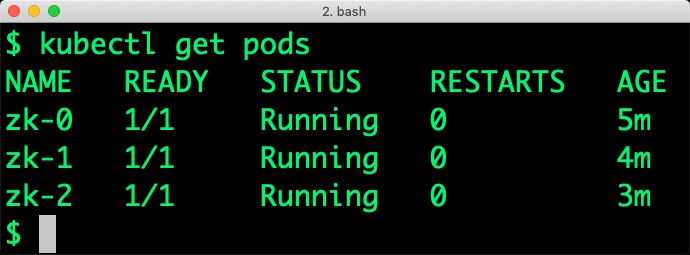
Let’s ensure that the ZooKeeper cluster is fully functional by creating and retrieving values from different nodes.
We create a key/value pair in node zk-0.
$ kubectl exec zk-0 -- /opt/zookeeper/bin/zkCli.sh create /hello world Connecting to localhost:2181 2019-01-02 06:46:23,163 [myid:] - INFO [main:Environment@100] - Client environment:zookeeper.version=3.4.9-1757313, built on 08/23/2016 06:50 GMT 2019-01-02 06:46:23,166 [myid:] - INFO [main:Environment@100] - Client environment:host.name=zk-0.zk-headless.default.svc.cluster.local 2019-01-02 06:46:23,167 [myid:] - INFO [main:Environment@100] - Client environment:java.version=1.8.0_111 2019-01-02 06:46:23,168 [myid:] - INFO [main:Environment@100] - Client environment:java.vendor=Oracle Corporation 2019-01-02 06:46:23,168 [myid:] - INFO [main:Environment@100] - Client environment:java.home=/usr/lib/jvm/java-8-openjdk-amd64/jre 2019-01-02 06:46:23,169 [myid:] - INFO [main:Environment@100] - Client environment:java.class.path=/opt/zookeeper/bin/../build/classes:/opt/zookeeper/bin/../build/lib/*.jar:/opt/zookeeper/bin/../lib/slf4j-log4j12-1.6.1.jar:/opt/zookeeper/bin/../lib/slf4j-api-1.6.1.jar:/opt/zookeeper/bin/../lib/netty-3.10.5.Final.jar:/opt/zookeeper/bin/../lib/log4j-1.2.16.jar:/opt/zookeeper/bin/../lib/jline-0.9.94.jar:/opt/zookeeper/bin/../zookeeper-3.4.9.jar:/opt/zookeeper/bin/../src/java/lib/*.jar:/opt/zookeeper/bin/../conf: 2019-01-02 06:46:23,169 [myid:] - INFO [main:Environment@100] - Client environment:java.library.path=/usr/java/packages/lib/amd64:/usr/lib/x86_64-linux-gnu/jni:/lib/x86_64-linux-gnu:/usr/lib/x86_64-linux-gnu:/usr/lib/jni:/lib:/usr/lib 2019-01-02 06:46:23,169 [myid:] - INFO [main:Environment@100] - Client environment:java.io.tmpdir=/tmp 2019-01-02 06:46:23,169 [myid:] - INFO [main:Environment@100] - Client environment:java.compiler= 2019-01-02 06:46:23,169 [myid:] - INFO [main:Environment@100] - Client environment:os.name=Linux 2019-01-02 06:46:23,169 [myid:] - INFO [main:Environment@100] - Client environment:os.arch=amd64 2019-01-02 06:46:23,169 [myid:] - INFO [main:Environment@100] - Client environment:os.version=4.15.0-1017-gcp 2019-01-02 06:46:23,169 [myid:] - INFO [main:Environment@100] - Client environment:user.name=zookeeper 2019-01-02 06:46:23,169 [myid:] - INFO [main:Environment@100] - Client environment:user.home=/home/zookeeper 2019-01-02 06:46:23,169 [myid:] - INFO [main:Environment@100] - Client environment:user.dir=/ 2019-01-02 06:46:23,170 [myid:] - INFO [main:ZooKeeper@438] - Initiating client connection, connectString=localhost:2181 sessionTimeout=30000 watcher=org.apache.zookeeper.ZooKeeperMain$MyWatcher@1de0aca6 2019-01-02 06:46:23,192 [myid:] - INFO [main-SendThread(localhost:2181):ClientCnxn$SendThread@1032] - Opening socket connection to server localhost/127.0.0.1:2181. Will not attempt to authenticate using SASL (unknown error) 2019-01-02 06:46:23,242 [myid:] - INFO [main-SendThread(localhost:2181):ClientCnxn$SendThread@876] - Socket connection established to localhost/127.0.0.1:2181, initiating session 2019-01-02 06:46:23,275 [myid:] - INFO [main-SendThread(localhost:2181):ClientCnxn$SendThread@1299] - Session establishment complete on server localhost/127.0.0.1:2181, sessionid = 0x1680d4b4f400000, negotiated timeout = 30000 WATCHER:: WatchedEvent state:SyncConnected type:None path:null Created /hello
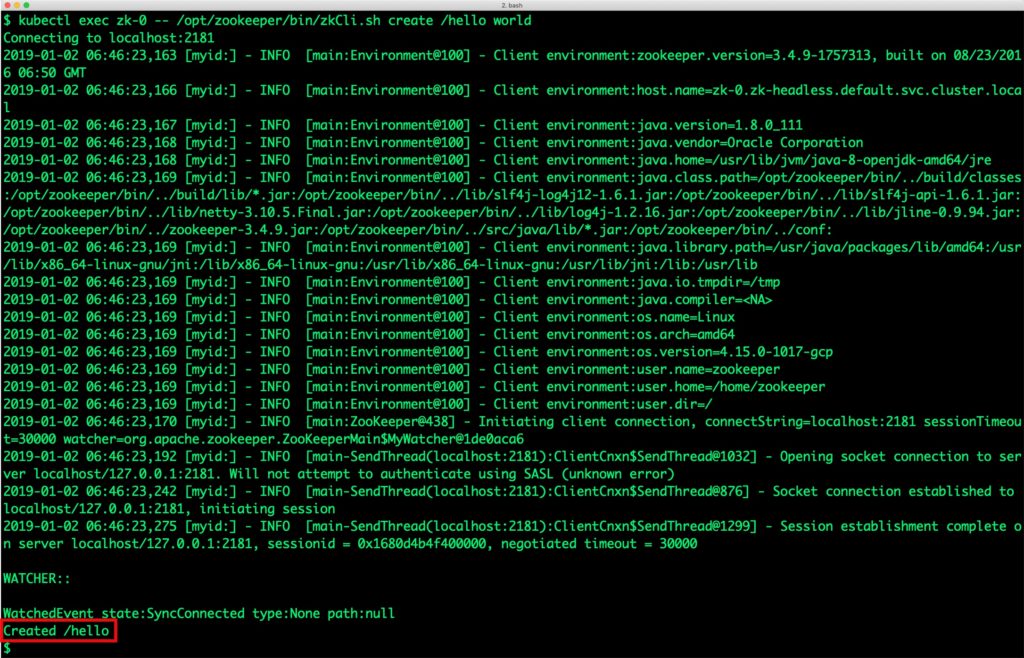
Let’s now retrieve the value from node zk-2.
$ kubectl exec zk-2 -- /opt/zookeeper/bin/zkCli.sh get /hello Connecting to localhost:2181 2019-01-02 06:49:53,232 [myid:] - INFO [main:Environment@100] - Client environment:zookeeper.version=3.4.9-1757313, built on 08/23/2016 06:50 GMT 2019-01-02 06:49:53,236 [myid:] - INFO [main:Environment@100] - Client environment:host.name=zk-2.zk-headless.default.svc.cluster.local 2019-01-02 06:49:53,236 [myid:] - INFO [main:Environment@100] - Client environment:java.version=1.8.0_111 2019-01-02 06:49:53,238 [myid:] - INFO [main:Environment@100] - Client environment:java.vendor=Oracle Corporation 2019-01-02 06:49:53,239 [myid:] - INFO [main:Environment@100] - Client environment:java.home=/usr/lib/jvm/java-8-openjdk-amd64/jre 2019-01-02 06:49:53,239 [myid:] - INFO [main:Environment@100] - Client environment:java.class.path=/opt/zookeeper/bin/../build/classes:/opt/zookeeper/bin/../build/lib/*.jar:/opt/zookeeper/bin/../lib/slf4j-log4j12-1.6.1.jar:/opt/zookeeper/bin/../lib/slf4j-api-1.6.1.jar:/opt/zookeeper/bin/../lib/netty-3.10.5.Final.jar:/opt/zookeeper/bin/../lib/log4j-1.2.16.jar:/opt/zookeeper/bin/../lib/jline-0.9.94.jar:/opt/zookeeper/bin/../zookeeper-3.4.9.jar:/opt/zookeeper/bin/../src/java/lib/*.jar:/opt/zookeeper/bin/../conf: 2019-01-02 06:49:53,239 [myid:] - INFO [main:Environment@100] - Client environment:java.library.path=/usr/java/packages/lib/amd64:/usr/lib/x86_64-linux-gnu/jni:/lib/x86_64-linux-gnu:/usr/lib/x86_64-linux-gnu:/usr/lib/jni:/lib:/usr/lib 2019-01-02 06:49:53,239 [myid:] - INFO [main:Environment@100] - Client environment:java.io.tmpdir=/tmp 2019-01-02 06:49:53,239 [myid:] - INFO [main:Environment@100] - Client environment:java.compiler= 2019-01-02 06:49:53,239 [myid:] - INFO [main:Environment@100] - Client environment:os.name=Linux 2019-01-02 06:49:53,239 [myid:] - INFO [main:Environment@100] - Client environment:os.arch=amd64 2019-01-02 06:49:53,240 [myid:] - INFO [main:Environment@100] - Client environment:os.version=4.15.0-1017-gcp 2019-01-02 06:49:53,240 [myid:] - INFO [main:Environment@100] - Client environment:user.name=zookeeper 2019-01-02 06:49:53,240 [myid:] - INFO [main:Environment@100] - Client environment:user.home=/home/zookeeper 2019-01-02 06:49:53,240 [myid:] - INFO [main:Environment@100] - Client environment:user.dir=/ 2019-01-02 06:49:53,241 [myid:] - INFO [main:ZooKeeper@438] - Initiating client connection, connectString=localhost:2181 sessionTimeout=30000 watcher=org.apache.zookeeper.ZooKeeperMain$MyWatcher@1de0aca6 2019-01-02 06:49:53,265 [myid:] - INFO [main-SendThread(localhost:2181):ClientCnxn$SendThread@1032] - Opening socket connection to server localhost/127.0.0.1:2181. Will not attempt to authenticate using SASL (unknown error) 2019-01-02 06:49:53,333 [myid:] - INFO [main-SendThread(localhost:2181):ClientCnxn$SendThread@876] - Socket connection established to localhost/127.0.0.1:2181, initiating session 2019-01-02 06:49:53,353 [myid:] - INFO [main-SendThread(localhost:2181):ClientCnxn$SendThread@1299] - Session establishment complete on server localhost/127.0.0.1:2181, sessionid = 0x3680d4c049c0000, negotiated timeout = 30000 WATCHER:: WatchedEvent state:SyncConnected type:None path:null cZxid = 0x100000002 world ctime = Wed Jan 02 06:46:23 UTC 2019 mZxid = 0x100000002 mtime = Wed Jan 02 06:46:23 UTC 2019 pZxid = 0x100000002 cversion = 0 dataVersion = 0 aclVersion = 0 ephemeralOwner = 0x0 dataLength = 5 numChildren = 0

Deploying Kafka StatefulSet on EKS
With the ZooKeeper cluster in place, it’s time for us to deploy our Kafka cluster. Let’s start by creating the ConfigMap and a headless service required by Kafka.
$ cat > kafka-config.yaml << EOF kind: ConfigMap metadata: name: broker-config namespace: default apiVersion: v1 data: init.sh: |- #!/bin/bash set -x KAFKA_BROKER_ID=${HOSTNAME##*-} cp -Lur /etc/kafka-configmap/* /etc/kafka/ sed -i "s/#init#broker.id=#init#/broker.id=$KAFKA_BROKER_ID/" /etc/kafka/server.properties hash kubectl 2>/dev/null || {
sed -i "s/#init#broker.rack=#init#/#init#broker.rack=# kubectl not found in path/" /etc/kafka/server.properties
} && {
ZONE=$(kubectl get node "$NODE_NAME" -o=go-template='{{index .metadata.labels "failure-domain.beta.kubernetes.io/zone"}}')
if [ $? -ne 0 ]; then
sed -i "s/#init#broker.rack=#init#/#init#broker.rack=# zone lookup failed, see -c init-config logs/" /etc/kafka/server.properties
elif [ "x$ZONE" == "x" ]; then
sed -i "s/#init#broker.rack=#init#/#init#broker.rack=# zone label not found for node $NODE_NAME/" /etc/kafka/server.properties
else
sed -i "s/#init#broker.rack=#init#/broker.rack=$ZONE/" /etc/kafka/server.properties
fi
}
server.properties: |-
delete.topic.enable=true
num.network.threads=3
num.io.threads=8
socket.send.buffer.bytes=102400
socket.receive.buffer.bytes=102400
socket.request.max.bytes=104857600
log.dirs=/tmp/kafka-logs
num.partitions=1
num.recovery.threads.per.data.dir=1
offsets.topic.replication.factor=1
transaction.state.log.replication.factor=1
transaction.state.log.min.isr=1
log.retention.hours=168
log.segment.bytes=1073741824
log.retention.check.interval.ms=300000
zookeeper.connect=zk-0.zk-headless.default.svc.cluster.local:2181,zk-1.zk-headless.default.svc.cluster.local:2181,zk-2.zk-headless.default.svc.cluster.local:2181
zookeeper.connection.timeout.ms=6000
group.initial.rebalance.delay.ms=0
log4j.properties: |-
log4j.rootLogger=INFO, stdout
log4j.appender.stdout=org.apache.log4j.ConsoleAppender
log4j.appender.stdout.layout=org.apache.log4j.PatternLayout
log4j.appender.stdout.layout.ConversionPattern=[%d] %p %m (%c)%n
log4j.appender.kafkaAppender=org.apache.log4j.DailyRollingFileAppender
log4j.appender.kafkaAppender.DatePattern='.'yyyy-MM-dd-HH
log4j.appender.kafkaAppender.File=${kafka.logs.dir}/server.log
log4j.appender.kafkaAppender.layout=org.apache.log4j.PatternLayout
log4j.appender.kafkaAppender.layout.ConversionPattern=[%d] %p %m (%c)%n
log4j.appender.stateChangeAppender=org.apache.log4j.DailyRollingFileAppender
log4j.appender.stateChangeAppender.DatePattern='.'yyyy-MM-dd-HH
log4j.appender.stateChangeAppender.File=${kafka.logs.dir}/state-change.log
log4j.appender.stateChangeAppender.layout=org.apache.log4j.PatternLayout
log4j.appender.stateChangeAppender.layout.ConversionPattern=[%d] %p %m (%c)%n
log4j.appender.requestAppender=org.apache.log4j.DailyRollingFileAppender
log4j.appender.requestAppender.DatePattern='.'yyyy-MM-dd-HH
log4j.appender.requestAppender.File=${kafka.logs.dir}/kafka-request.log
log4j.appender.requestAppender.layout=org.apache.log4j.PatternLayout
log4j.appender.requestAppender.layout.ConversionPattern=[%d] %p %m (%c)%n
log4j.appender.cleanerAppender=org.apache.log4j.DailyRollingFileAppender
log4j.appender.cleanerAppender.DatePattern='.'yyyy-MM-dd-HH
log4j.appender.cleanerAppender.File=${kafka.logs.dir}/log-cleaner.log
log4j.appender.cleanerAppender.layout=org.apache.log4j.PatternLayout
log4j.appender.cleanerAppender.layout.ConversionPattern=[%d] %p %m (%c)%n
log4j.appender.controllerAppender=org.apache.log4j.DailyRollingFileAppender
log4j.appender.controllerAppender.DatePattern='.'yyyy-MM-dd-HH
log4j.appender.controllerAppender.File=${kafka.logs.dir}/controller.log
log4j.appender.controllerAppender.layout=org.apache.log4j.PatternLayout
log4j.appender.controllerAppender.layout.ConversionPattern=[%d] %p %m (%c)%n
log4j.appender.authorizerAppender=org.apache.log4j.DailyRollingFileAppender
log4j.appender.authorizerAppender.DatePattern='.'yyyy-MM-dd-HH
log4j.appender.authorizerAppender.File=${kafka.logs.dir}/kafka-authorizer.log
log4j.appender.authorizerAppender.layout=org.apache.log4j.PatternLayout
log4j.appender.authorizerAppender.layout.ConversionPattern=[%d] %p %m (%c)%n
# Change the two lines below to adjust ZK client logging
log4j.logger.org.I0Itec.zkclient.ZkClient=INFO
log4j.logger.org.apache.zookeeper=INFO
# Change the two lines below to adjust the general broker logging level (output to server.log and stdout)
log4j.logger.kafka=INFO
log4j.logger.org.apache.kafka=INFO
# Change to DEBUG or TRACE to enable request logging
log4j.logger.kafka.request.logger=WARN, requestAppender
log4j.additivity.kafka.request.logger=false
log4j.logger.kafka.network.RequestChannel$=WARN, requestAppender
log4j.additivity.kafka.network.RequestChannel$=false
log4j.logger.kafka.controller=TRACE, controllerAppender
log4j.additivity.kafka.controller=false
log4j.logger.kafka.log.LogCleaner=INFO, cleanerAppender
log4j.additivity.kafka.log.LogCleaner=false
log4j.logger.state.change.logger=TRACE, stateChangeAppender
log4j.additivity.state.change.logger=false
log4j.logger.kafka.authorizer.logger=WARN, authorizerAppender
log4j.additivity.kafka.authorizer.logger=false
---
apiVersion: v1
kind: Service
metadata:
name: kafka-broker
namespace: default
spec:
ports:
- port: 9092
# [podname].broker.kafka.svc.cluster.local
clusterIP: None
selector:
app: kafka
---
EOF
$ kubectl create -f kafka-config.yaml configmap/broker-config created service/kafka-broker created
Deploy Kafka cluster with a single node with the below manifest:
$ cat > kafka-ss.yaml << EOF
apiVersion: apps/v1
kind: StatefulSet
metadata:
name: kafka
namespace: default
spec:
selector:
matchLabels:
app: kafka
serviceName: "kafka-broker"
replicas: 1
template:
metadata:
labels:
app: kafka
annotations:
spec:
# Use the stork scheduler to enable more efficient placement of the pods
schedulerName: stork
terminationGracePeriodSeconds: 30
affinity:
nodeAffinity:
requiredDuringSchedulingIgnoredDuringExecution:
nodeSelectorTerms:
- matchExpressions:
- key: px/running
operator: NotIn
values:
- "false"
- key: px/enabled
operator: NotIn
values:
- "false"
initContainers:
- name: init-config
image: solsson/kafka-initutils@sha256:c275d681019a0d8f01295dbd4a5bae3cfa945c8d0f7f685ae1f00f2579f08c7d
env:
- name: NODE_NAME
valueFrom:
fieldRef:
fieldPath: spec.nodeName
command: ['/bin/bash', '/etc/kafka-configmap/init.sh']
volumeMounts:
- name: configmap
mountPath: /etc/kafka-configmap
- name: config
mountPath: /etc/kafka
containers:
- name: broker
image: solsson/kafka:0.11.0.0@sha256:b27560de08d30ebf96d12e74f80afcaca503ad4ca3103e63b1fd43a2e4c976ce
env:
- name: KAFKA_LOG4J_OPTS
value: -Dlog4j.configuration=file:/etc/kafka/log4j.properties
ports:
- containerPort: 9092
command:
- ./bin/kafka-server-start.sh
- /etc/kafka/server.properties
- --override
- zookeeper.connect=zk-0.zk-headless.default.svc.cluster.local:2181,zk-1.zk-headless.default.svc.cluster.local:2181,zk-2.zk-headless.default.svc.cluster.local:2181
- --override
- log.retention.hours=-1
- --override
- log.dirs=/var/lib/kafka/data/topics
- --override
- auto.create.topics.enable=false
resources:
requests:
cpu: 100m
memory: 512Mi
readinessProbe:
exec:
command:
- /bin/sh
- -c
- 'echo "" | nc -w 1 127.0.0.1 9092'
volumeMounts:
- name: config
mountPath: /etc/kafka
- name: data
mountPath: /var/lib/kafka/data
volumes:
- name: configmap
configMap:
name: broker-config
- name: config
emptyDir: {}
volumeClaimTemplates:
- metadata:
name: data
spec:
storageClassName: portworx-sc-rep3
accessModes: [ "ReadWriteOnce" ]
resources:
requests:
storage: 3Gi
EOF
$ kubectl create -f kafka-ss.yaml statefulset.apps/kafka created
To make it easy to communicate with the Kafka cluster, let’s create a Pod with the Kafka CLI.
$ cat > kafka-cli.yaml << EOF
apiVersion: v1
kind: Pod
metadata:
name: kafka-cli
spec:
containers:
- name: kafka
image: solsson/kafka:0.11.0.0
command:
- sh
- -c
- "exec tail -f /dev/null"
EOF
$ kubectl create -f kafka-cli.yaml pod/kafka-cli created
Verify that the Kafka StatefulSet is up and running.
$ kubectl get pods -l app=kafka NAME READY STATUS RESTARTS AGE kafka-0 1/1 Running 0 3m
We can now inspect the Portworx volume associated with the Kafka pod by accessing the pxctl tool.
$ VOL=`kubectl get pvc | grep kafka | awk '{print $3}'`
$ PX_POD=$(kubectl get pods -l name=portworx -n kube-system -o jsonpath='{.items[0].metadata.name}')
$ kubectl exec -it $PX_POD -n kube-system -- /opt/pwx/bin/pxctl volume inspect ${VOL}
Volume : 692967637135124169
Name : pvc-dd6d4c89-22bc-11e9-9dd5-067c337f5398
Group : kafka_vg
Size : 3.0 GiB
Format : ext4
HA : 3
IO Priority : LOW
Creation time : Jan 28 05:23:37 UTC 2019
Shared : no
Status : up
State : Attached: 3b50ecde-6868-4973-8f53-31fccf850d21 (192.168.48.2)
Device Path : /dev/pxd/pxd692967637135124169
Labels : namespace=default,pvc=data-kafka-0
Reads : 13
Reads MS : 8
Bytes Read : 53248
Writes : 117
Writes MS : 1992
Bytes Written : 50520064
IOs in progress : 0
Bytes used : 984 KiB
Replica sets on nodes:
Set 0
Node : 192.168.48.2 (Pool 0)
Node : 192.168.13.157 (Pool 0)
Node : 192.168.66.242 (Pool 0)
Replication Status : Up
Volume consumers :
- Name : kafka-0 (dd6e3756-22bc-11e9-9dd5-067c337f5398) (Pod)
Namespace : default
Running on : ip-192-168-48-2.us-west-2.compute.internal
Controlled by : kafka (StatefulSet)

Failing over a Kafka pod on Kubernetes
Let’s start by ingesting sample messages into a topic through the CLI pod. Hit CTRL+C after entering the last message.
$ kubectl exec -it kafka-cli bash # ./bin/kafka-topics.sh --create --zookeeper zk-headless:2181 --replication-factor 1 --partitions 1 --topic test # ./bin/kafka-console-producer.sh --broker-list kafka-broker:9092 --topic test >message 1 >message 2 >message 3 # ./bin/kafka-console-consumer.sh --bootstrap-server kafka-broker:9092 --topic test --partition 0 --from-beginning message 1 message 2 message 3 Processed a total of 3 messages # exit
We will now simulate the failover by cordoning off one of the nodes and deleting the Kafka Pod deployed on it. When the new Pod is created it has the same data as the original Pod.
$ NODE=`kubectl get pods -o wide | grep kafka-0 | awk '{print $7}'`
$ kubectl cordon ${NODE}
node/ip-192-168-48-2.us-west-2.compute.internal cordoned

$ kubectl delete pod kafka-0 pod "kafka-0" deleted
Kubernetes controller now tries to create the Pod on a different node. Wait for the Kafka Pod to be in Running state on the node. Don’t forget to uncordon the node before proceeding further.
$ kubectl get pods -l app=kafka -o wide NAME READY STATUS RESTARTS AGE IP NODE NOMINATED NODE kafka-0 1/1 Running 0 22s 192.168.68.183 ip-192-168-66-242.us-west-2.compute.internal

$ kubectl uncordon ${NODE}
node/ip-192-168-48-2.us-west-2.compute.internal uncordoned
Finally, let’s verify that the messages are still available under the test topic.
$ kubectl exec -it kafka-cli bash # ./bin/kafka-console-consumer.sh --bootstrap-server kafka-broker:9092 --topic test --partition 0 --from-beginning message 1 message 2 message 3 Processed a total of 3 messages
Backing up and restoring a Kafka node through snapshots
Portworx supports creating Snapshots for Kubernetes PVCs. Since there is only one Kafka node, we can use regular, local snapshots to backup and restore.
For production scenarios where there is more than one Kafka node in the cluster, it is highly recommended that customers use 3DSnap for application consistent backup and recovery.
Let’s create a snapshot for the Kubernetes PVC we created for MySQL.
cat > kafka-snap.yaml << EOF apiVersion: volumesnapshot.external-storage.k8s.io/v1 kind: VolumeSnapshot metadata: name: px-kafka-snapshot namespace: default spec: persistentVolumeClaimName: data-kafka-0 EOF
$ kubectl create -f kafka-snap.yaml volumesnapshot.volumesnapshot.external-storage.k8s.io "px-kafka-snapshot" created
Verify the creation of the volume snapshot.
$ kubectl get volumesnapshot NAME AGE px-kafka-snapshot 30s
$ kubectl get volumesnapshotdatas NAME AGE k8s-volume-snapshot-b1c06e67-1feb-11e9-8f35-0a580a30020a 34s
With the snapshot in place, let’s go ahead and delete the Kafka StatefulSet and the associated PVC.
$ kubectl delete sts/kafka statefulset.apps "kafka" deleted
$ kubectl delete sts/kafka persistentvolumeclaim "data-kafka-0" deleted
Since snapshots are just like volumes, we can use it to create a new PVC. Since we follow the standard naming convention used by Kubernetes StatefulSets, the Kafka node will be automatically associated with this PVC.
Create a new PVC definition from the snapshot. Notice how the new PVC is named. It’s the same as the original PVC that we deleted after taking the snapshot.
cat > kafka-snap.yaml << EOF
apiVersion: v1
kind: PersistentVolumeClaim
metadata:
name: data-kafka-0
annotations:
snapshot.alpha.kubernetes.io/snapshot: px-kafka-snapshot
spec:
accessModes:
- ReadWriteOnce
storageClassName: stork-snapshot-sc
resources:
requests:
storage: 5Gi
EOF
$ kubectl create -f kafka-snap-pvc.yaml persistentvolumeclaim/data-kafka-0 created
Launch a new StatefulSet backed by the restored PVC.
$ kubectl create -f kafka-ss.yaml statefulset.apps/kafka created
Once the Pod is ready, let’s access it through the CLI Pod to check the availability of messages sent by the producer.
$ kubectl exec -it kafka-cli bash root@kafka-cli:/opt/kafka# ./bin/kafka-console-consumer.sh --bootstrap-server kafka-broker:9092 --topic test --partition 0 --from-beginning msg 1 msg 2 msg 3 Processed a total of 3 messages root@kafka-cli:/opt/kafka#
Congratulations! You have successfully restored a snapshot for Kafka.
Summary
Portworx can easily be deployed on Amazon EKS to run stateful workloads in production. It integrates well with Kubernetes StatefulSets by providing dynamic provisioning. Additional operations such as expanding the volumes and performing backups stored as snapshots on object storage can be performed while managing production workloads.
Share
Subscribe for Updates
About Us
Portworx is the leader in cloud native storage for containers.
Thanks for subscribing!

Janakiram MSV
Contributor | Certified Kubernetes Administrator (CKA) and Developer (CKAD)Explore Related Content:
- databases
- eks
- kafka
- kubernetes


